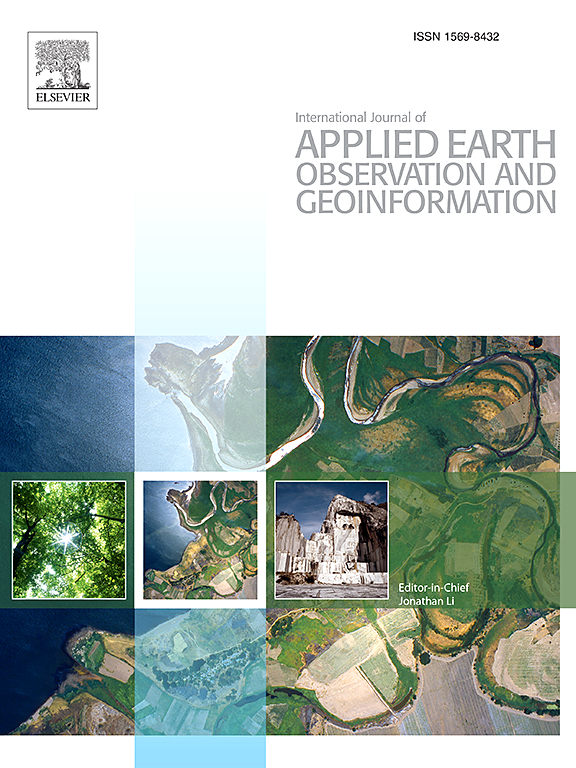Comparison of different downscaling schemes for obtaining regional high-resolution soil moisture data
IF 8.6
Q1 REMOTE SENSING
International journal of applied earth observation and geoinformation : ITC journal
Pub Date : 2025-06-09
DOI:10.1016/j.jag.2025.104652
引用次数: 0
Abstract
Obtaining regional fine-scale daily Soil Moisture (SM) data is crucial for better understanding carbon and water cycles. Currently, downscaling from passive microwave SM products has become the most commonly utilized approach for generating regional high-resolution SM data, while retrieving SM based on disaggregated brightness Temperature (TB) data gains litter attention. Besides, the relative potentials of these two downscaling approaches remains largely unknown. Therefore, this study comprehensively compared the relatively performances of the two downscaling schemes namely the “retrieving-then-downscaling” and “downscaling-then-retrieving” over the Qinghai-Tibet Plateau (QTP). Evaluation results showed that retrieving SM using disaggregated TB significantly outperformed the popular passive microwave SM downscaling method. The averaged R and ubRMSE metrics for downscale-first based SM were 0.62/0.74 and 0.051/0.038 m3/m3 at station/network scales, and were 0.58/0.70 and 0.056/0.041 m3/m3 for the retrieval-first based SM, respectively. Spatially, the downscale-first based SM had lower uncertainty than the retrieval-first based SM over nearly 70 % areas of the QTP. However, due to the strong vegetation scattering effect, it showed two times larger uncertainty than the retrieval-first based SM over densely vegetated regions in the east and southeast. In addition, satisfactory TB downscaling performance could be achieved by leveraging machine learning algorithms and multiple covariables, but need to further reduce additional errors. The superiority of “downscaling-then-retrieving” scheme was independent of models selected for downscaling. In conclusion, this study demonstrates the great potential of “downscaling-then-retrieving” method and provides a new insight for generating regional SM data at fine scale.
获取区域高分辨率土壤湿度数据的不同降尺度方案比较
获取区域精细尺度土壤水分(SM)日数据对于更好地理解碳和水循环至关重要。目前,对无源微波SM产品进行降尺度处理已成为生成区域高分辨率SM数据最常用的方法,而基于分解后的亮度温度(TB)数据检索SM数据却很少受到关注。此外,这两种缩小方法的相对潜力在很大程度上仍然未知。因此,本研究综合比较了青藏高原“先反演后降尺度”和“先降尺度后反演”两种降尺度方案的相对性能。评价结果表明,利用分解后的TB检索SM显著优于常用的被动微波SM降尺度方法。在站点/网络尺度上,降尺度优先SM的平均R和ubRMSE分别为0.62/0.74和0.051/0.038 m3/m3,在检索优先SM的平均R和ubRMSE分别为0.58/0.70和0.056/0.041 m3/m3。从空间上看,在近70%的QTP面积上,基于降尺度优先的SM比基于检索优先的SM具有更低的不确定性。但在东部和东南部植被密集地区,由于植被散射效应强,其不确定性比基于反演优先的SM大2倍。此外,利用机器学习算法和多个协变量可以实现令人满意的TB降尺度性能,但需要进一步减少额外的误差。“先降尺度后检索”方案的优越性与降尺度选择的模型无关。综上所述,该研究证明了“先降尺度后检索”方法的巨大潜力,为精细尺度下区域SM数据的生成提供了新的思路。
本文章由计算机程序翻译,如有差异,请以英文原文为准。
求助全文
约1分钟内获得全文
求助全文
来源期刊

International journal of applied earth observation and geoinformation : ITC journal
Global and Planetary Change, Management, Monitoring, Policy and Law, Earth-Surface Processes, Computers in Earth Sciences
CiteScore
12.00
自引率
0.00%
发文量
0
审稿时长
77 days
期刊介绍:
The International Journal of Applied Earth Observation and Geoinformation publishes original papers that utilize earth observation data for natural resource and environmental inventory and management. These data primarily originate from remote sensing platforms, including satellites and aircraft, supplemented by surface and subsurface measurements. Addressing natural resources such as forests, agricultural land, soils, and water, as well as environmental concerns like biodiversity, land degradation, and hazards, the journal explores conceptual and data-driven approaches. It covers geoinformation themes like capturing, databasing, visualization, interpretation, data quality, and spatial uncertainty.
 求助内容:
求助内容: 应助结果提醒方式:
应助结果提醒方式:


